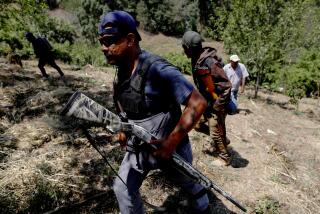Taking on the cartels
Squeeze the balloon in one place, and it expands in another. That pretty well describes the history of narcotics trafficking from Latin America to the United States. For decades, Colombia’s two big cartels controlled the illegal drug trade from South America’s coca fields to U.S. cities, and Mexico served largely as a transshipment point. But as law enforcement agencies broke up the Medellin and Cali cartels over the last decade, Mexicans stepped in to fill the void.
Today, Mexico’s big three -- the Sinaloa, Gulf and Tijuana cartels -- control most of the wholesale and retail sales of drugs to U.S. consumers from San Diego to Boston. They grew by increasing production of marijuana, heroin and methamphetamine within Mexico, while demanding bigger cuts of the profits from the Colombian cocaine cartels whose product they were moving over the U.S. border.
The Mexican cartels’ enormous size and power were evident in the arrests this week of more than 50 people in California, Minnesota, Maryland and Washington, D.C., who allegedly work for the Sinaloa cartel. The busts were part of a 21-month operation by U.S. and Mexican officials that they say has netted more than 730 people in the United States and Mexico, along with nearly $60 million in cash, 24,000 pounds of cocaine, 1,200 pounds of methamphetamine, plus other drugs, assets and weapons. The arrests, an example of impressive cooperation between U.S. and Mexican law enforcement officials, are welcome, as is any crackdown on illicit trafficking. But it’s a drop in the bucket against the overwhelming tide of drugs crossing the border, and illustrates the limits of concentrating on only that aspect of the trade. The Obama administration has to tackle other key elements of the drug business: money laundering, weapons trafficking from the U.S. to Mexico, and demand.
The National Drug Intelligence Center estimates that Mexican and Colombian cartels launder between $18 billion and $39 billion in wholesale drug proceeds annually. A large percentage of that money is smuggled in bulk -- in bags full of cash -- south across the U.S.-Mexico border. And despite a few high-profile arrests of border gun dealers, the U.S. and Mexican governments say 90% of all weapons seized in drug-related crimes in Mexico come from the United States. These are high-powered machine guns, fragmentation grenades and rocket-propelled grenade launchers that give the traffickers more firepower than Mexican police.
The U.S. government must crack down on drug-money laundering with the same rigor it has applied to terrorist finance networks, and should consider implementing routine inspections of vehicles heading south -- much as it searches for illegal immigrants heading north. And finally, the administration must do more to attack demand. As long as there is money and a market, there will be a supply.
More to Read
Sign up for Essential California
The most important California stories and recommendations in your inbox every morning.
You may occasionally receive promotional content from the Los Angeles Times.










